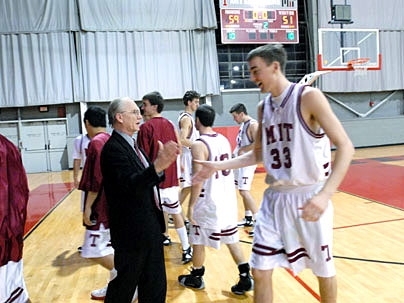As a once nationally ranked swimmer and rower, Professor Leigh Royden of earth, atmospheric and planetary sciences knows the challenges of balancing academics and varsity athletics.
"I basically majored in crew," said Royden, recalling with a laugh her undergraduate years spent rowing for Harvard University. "It is easy for faculty members to forget what it is like to be their age," she added, referring to the undergraduate students.
As part of the Varsity Sport Faculty Mentor Program, Royden uses her personal knowledge to mentor both the men's and women's swimming teams.
Launched in January 2005, the program is designed to build a bridge between the academic and athletic lives of student athletes. "We had been looking for a way to engage the student athletes with faculty members," said John Benedick, assistant director of athletics for sports administration.
Currently, 20 of the 41 varsity teams at MIT have faculty mentors. "We want to continue to expand it," Benedick said.
"If we could get 10 percent of the faculty to do this, then we would have a critical mass of faculty who understand the importance of varsity athletics in the scheme of things," said J. Kim Vandiver, dean for undergraduate research and one of the faculty mentors for men's basketball.
"Historically, varsity athletics were sometimes considered a nuisance," Vandiver said. Due to the inevitable scheduling conflicts between athletics and academics, many faculty members took a dim view of sports, he said.
Current research finds that sports are a vital part of the "total health and wellness package," Vandiver said. "Exercise is great for stress control, and student athletes are generally better at managing their time."
Faculty mentors can share that perspective with others, Vandiver said. "We are able to bring to the table a new point of view that varsity athletics make an important contribution to the overall performance and health of our students," Vandiver said.
Vandiver sees the program as opening the lines of communication between athletics and academics; advisors can get to know their advisees better and be better equipped to help them succeed.
For the coaches, that link is also helpful, said swimming coach Dawn Gerken. "It is great to have that connection. The MIT faculty is very supportive, but having a faculty member connected to us really helps cement that bond," she said.��
For Royden, who participates in many of the swim practices, the program offers an opportunity to get to know students in a different way. "When I am in the pool, I want to break down the barrier I have in the classroom," she said.
"A lot of students go through MIT and never get to know a faculty member well," Royden said, adding that the program "basically brings together the two sides of Mass. Ave."
As Vandiver said, "The intimidation factor (between students and faculty) is greatly reduced."
A version of this article appeared in MIT Tech Talk on February 1, 2006 (download PDF).






